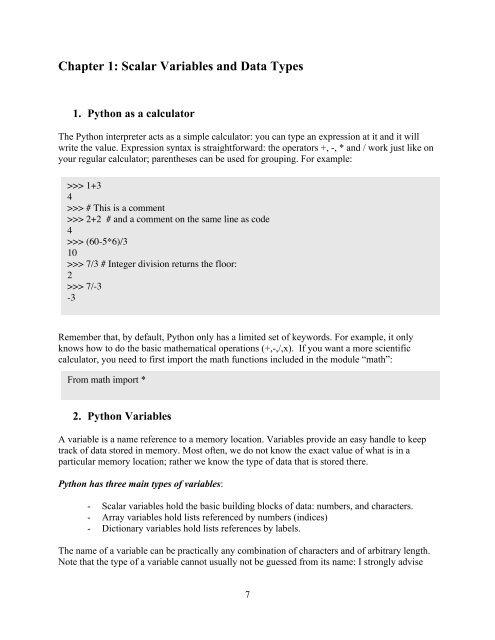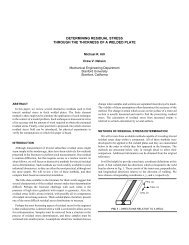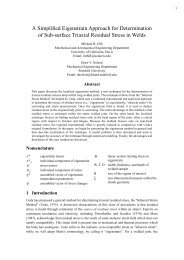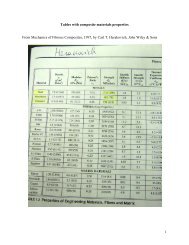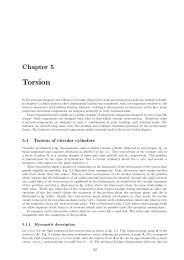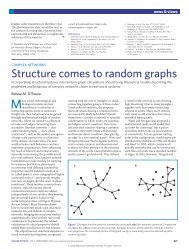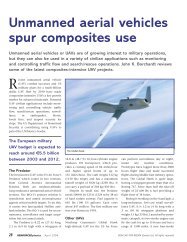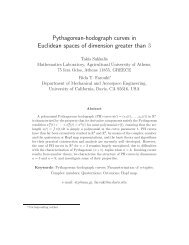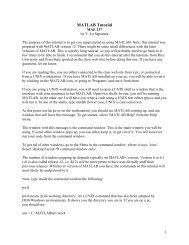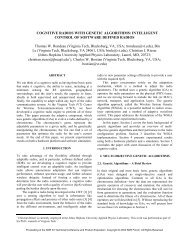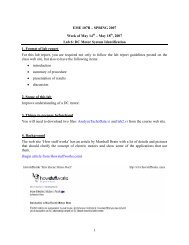Python Primer, Chap 1
Python Primer, Chap 1
Python Primer, Chap 1
You also want an ePaper? Increase the reach of your titles
YUMPU automatically turns print PDFs into web optimized ePapers that Google loves.
<strong>Chap</strong>ter 1: Scalar Variables and Data Types<br />
1. <strong>Python</strong> as a calculator<br />
The <strong>Python</strong> interpreter acts as a simple calculator: you can type an expression at it and it will<br />
write the value. Expression syntax is straightforward: the operators +, -, * and / work just like on<br />
your regular calculator; parentheses can be used for grouping. For example:<br />
>>> 1+3<br />
4<br />
>>> # This is a comment<br />
>>> 2+2 # and a comment on the same line as code<br />
4<br />
>>> (60-5*6)/3<br />
10<br />
>>> 7/3 # Integer division returns the floor:<br />
2<br />
>>> 7/-3<br />
-3<br />
Remember that, by default, <strong>Python</strong> only has a limited set of keywords. For example, it only<br />
knows how to do the basic mathematical operations (+,-,/,x). If you want a more scientific<br />
calculator, you need to first import the math functions included in the module “math”:<br />
From math import *<br />
2. <strong>Python</strong> Variables<br />
A variable is a name reference to a memory location. Variables provide an easy handle to keep<br />
track of data stored in memory. Most often, we do not know the exact value of what is in a<br />
particular memory location; rather we know the type of data that is stored there.<br />
<strong>Python</strong> has three main types of variables:<br />
- Scalar variables hold the basic building blocks of data: numbers, and characters.<br />
- Array variables hold lists referenced by numbers (indices)<br />
- Dictionary variables hold lists references by labels.<br />
The name of a variable can be practically any combination of characters and of arbitrary length.<br />
Note that the type of a variable cannot usually not be guessed from its name: I strongly advise<br />
7
you to choose a name for a variable that makes this type explicit. For example you can use<br />
names like X, X_list, X_dic to define a scalar, a list, and a dictionary, respectively.<br />
There are a few rules regarding variable names that you need to be aware of:<br />
- The first character of the name of a variable cannot be a digit<br />
- Spaces are one type of characters that are not allowed: use underscore instead.<br />
- Variables are case sensitive: this means that abc refers to a different location in<br />
memory than ABC.<br />
Creating a variable is as simple as making up a variable name and assigning a value to it.<br />
Assigning a value to a variable is easy: all you have to do is write an equation, with the variable<br />
name on the left, an = sign, and the value on the left. The = sign is called the assignment<br />
operator:<br />
>>>Width=4 # Note that the value of an assignment is not written<br />
>>>Height=3*12<br />
>>>Area=Width*Height<br />
>>>print Area<br />
144<br />
>>>x=y=z=0 # <strong>Python</strong> allows multiple assignments: x, y and z are<br />
set to 0<br />
>>>DNA=’aattgcg’ # assign a string variable<br />
>>>Name_list=[‘John’,’David’] # set up a list of names<br />
3. Special variable<br />
<strong>Python</strong> has one special variable, _, that points to the place in memory that stores the more recent<br />
result:<br />
>>> 4+5<br />
9<br />
>>>print _<br />
9<br />
This special variable “_” should be considered as “read-only”, i.e. I strongly advise against<br />
assigning a value to it!!<br />
4. Scalar variables<br />
<strong>Python</strong> has two types of scalar values: numbers and strings. Both types ca be assigned to a scalar<br />
variable.<br />
8
4.1 Numbers<br />
Numbers are specified in any of the common integer or floating point format:<br />
>>>x = 1 # Integer<br />
>>>y = 5.14 # Floating point<br />
>>>z = 3.25E-7 # Scientific notation<br />
Numbers can also be represented using binary or hexadecimal notations, but we will not need<br />
that.<br />
Table of the most common number operators in <strong>Python</strong>:<br />
Operator Meaning<br />
= Assign<br />
+ Add<br />
- Subtract<br />
* Multiply<br />
/ Divide<br />
** Exponentiation<br />
% Modulus<br />
abs(x) Absolute value of x<br />
int(x) x converted to integer<br />
float(x) x converted to float<br />
+= Assign add<br />
-= Assign subtract<br />
*= Assign multiply<br />
/= Assign divide<br />
<strong>Python</strong> allows us to use all standard arithmetic operators on numbers, plus a few others. The<br />
mathematical operations are performed in the standard order of precedence: power comes first,<br />
then multiplication has a higher precedence than addition and subtraction: 2+3*4 is equal to 14,<br />
and not 20. If we want the multiplication to be performed on 2+3, we need to include<br />
parentheses: (2+3)*4. These are exactly the rules used by <strong>Python</strong>.<br />
Some of the operators listed in the table above are unusual, and require more explanations:<br />
The modulo operator:<br />
i=52<br />
j=3<br />
k=i%j<br />
In the example given above, the variable k holds the remainder of the division of 52 by 3, i.e. 1.<br />
9
Operating and assigning at once:<br />
Operations that fetch a value from memory, modify it and store it back in memory are very<br />
common: <strong>Python</strong> has introduced a special syntax for those. Generally:<br />
i = i b;<br />
can be written as:<br />
i = b;<br />
Let us see an example:<br />
#<br />
a = 5*4<br />
print “5 times four is “, a, “\n”<br />
$a +=4<br />
print “Plus four is “,a,”\n”<br />
$a/=3<br />
print “Divided by three is “,a,”\n”<br />
In this example, “a” takes successively the values 20, 24 and 8.<br />
This works for +=, -=, *=, /=, **= and %=.<br />
4.2 Strings<br />
A string is a group of characters attached together, enclosed by quotation marks. For now, we<br />
will only consider double quotes.<br />
Just like with numbers, many operations can be performed on strings: the most common ones are<br />
listed in the table below.<br />
10
String operator Meaning<br />
a+b Concatenates strings a and b<br />
a*i Repeats string a i times<br />
a[i:j:k] Returns a string containing all characters of a<br />
between position i and j, with step k; if k is<br />
negative, starts from the right<br />
a[::-1] Returns a string that is the reverse of a<br />
a.split(sep) Split string a into a list, using sep to decide<br />
where to cut<br />
a.strip() Returns a string equal to a, but that has been<br />
stripped of any “white” characters at the<br />
beginning and end of a (space, tab, CR,…)<br />
a.upper() Returns a string equal to a, but with all letters<br />
uppercase<br />
a.lower() Returns a string equal to a, but with all letters<br />
lowercase<br />
a.capitalize() Returns a string equal to a, but with the first<br />
word capitalized<br />
a.count(‘sub’) Counts the number of instances of the<br />
substring ‘sub’ in the string a<br />
a.replace(‘sub1’,’sub2’,n) Returns a string equal to a, but with n instances<br />
of substring sub1 replaced with substring sub2;<br />
if n is not given, all instances are returned<br />
Concatenating strings:<br />
The + operator, when placed between two strings, creates a single string that concatenates the<br />
two original strings. In the following example:<br />
#<br />
>>>A==”ATTGC”<br />
>>>B=”GGCCT”<br />
>>>C=A+B<br />
The variable C contains the string “ATTGCGGCCT”. Note that the concatenation operator can<br />
be attached to an assignment:<br />
C+=”G”;<br />
Adds a “G” at the end of the string contained in C.<br />
Repeating a string<br />
The operator “*” repeats a string a given number of times:<br />
11
text=”No! “<br />
>>>newtext=text*5<br />
>>> print newtext<br />
No! No! No! No! No!<br />
Indexing and slicing strings<br />
Characters within a string can be accessed both front and backwards. Frontways, a string starts at<br />
position 0 and the character desired is found via an offset value:<br />
String[i] is the character at position i (starting from 0) from the left side of the string.<br />
You can also find the same character by using a negative offset value from the end of the string:<br />
String[-i] is the character at position i from the right side of the string.<br />
>>> S = ‘Index’<br />
>>> S[0]<br />
I<br />
>>> S[3]<br />
e<br />
>>> S[-1]<br />
x<br />
>>> S[-3]<br />
d<br />
Slicing is a very useful and heavily used function in <strong>Python</strong>: it allows you to extract specific<br />
substrings of a string. The syntax for slicing is:<br />
b = S[i:j:k]<br />
b collects characters between positions i and j (j not included), starting at I, every k characters.<br />
Note that you do not have to specify i, j and/or k:<br />
- if you do not specify i, you start at the first character of the string<br />
- if you do not specify j, you go up to the last character of the string<br />
- if you do not specify k, it is set by default to 1<br />
Note also that k can be negative, in which case you start from the right end of the string. For<br />
example,<br />
b = S[::-1]<br />
reverses the string S and stores it in b.<br />
12
Examples:<br />
>>> S = ‘This is a string’<br />
>>> b = S[1:3] # Select substring from position 1 to 3, 3 not included<br />
>>> print b<br />
‘hi’<br />
>>> S[5:12:3] # Select every third character, between position 5 and 10<br />
‘iat’<br />
>>> S[1:5:-1] # Starts from the end of the string; but order 1:5 is wrong<br />
get nothing:<br />
‘’<br />
>>> S[5:1:-1] # correct syntax<br />
‘i si’<br />
>>> S[10::] # all characters from position 10 till the end<br />
‘string’<br />
>>> S[::-1] # reverse the whole string<br />
‘gnirts a si sihT’<br />
The other string manipulations described below apply a function on the string. The syntax is:<br />
string.function(argument)<br />
where string is the string considered, function is the function applied, and argument are<br />
parameters for the function, if any.<br />
Breaking a string into a list<br />
A string can be broken down into a list using the function split. The syntax is:<br />
A.split(sep)<br />
where A is the string, and sep the separator. If sep is not provided, <strong>Python</strong> uses the white space.<br />
Examples:<br />
>>>text=”This is a test case; it has two parts”<br />
>>>text.split()<br />
[‘This’,’is’,’a’,’test’,’case;’,’it’,’has’,’two’,’parts’]<br />
>>> text.split(‘;’)<br />
[‘This is a test case’,’ it has two parts’]<br />
>>> text.split(‘a’)<br />
[‘This is ‘,’ test c’,’se; it h’,’s two p’,’rts’]<br />
13
Striping a string<br />
A string may have leading or lagging white characters, such as blanks, tabs, or carriage return. It<br />
is a good idea to remove those, using the function strip().<br />
Changing case<br />
- Setting the whole string as upper case: apply function upper()<br />
- Setting the whole string as lower case: apply function lower()<br />
- Capitalizing the string: apply function capitalize()<br />
>>> S = ‘This Is A Test’<br />
>>> S.upper() # All upper case<br />
‘THIS IS A TEST’<br />
>>> S.lower() # All lower case<br />
‘this is a test’<br />
>>> S.lower().capitalize() # Set proper case<br />
‘This is a test’<br />
>>> S = ‘ This is a test ‘ # Remove leading and lagging tabs<br />
‘This is a test’<br />
Counting occurrence of substrings<br />
Count is a function that finds and counts the number of occurrence of a substring in a string:<br />
>>> S=’aattggccttaa’<br />
>>> S.count(‘a’) # Number of character ‘a’ in the string<br />
4<br />
>>> S.count(‘A’)<br />
0 # Remember that python is case sensitive<br />
>>> S.count(‘at’) # Number of ‘at’ in the string<br />
1<br />
>>> S.count(‘Gc’)<br />
0<br />
Replace<br />
Replace is a function that substitutes a string for another:<br />
String.replace(‘sub1’,’sub2’,n)<br />
String is the string on which replace is applied; n instances of ‘sub1’ are replaced with ‘sub2’; if<br />
n is not provided, all instances of ‘sub1’ are replaced.<br />
14
S=’This is a test case’<br />
>>> S.replace(‘is’,’was’) # replaces all instances of ‘is’<br />
‘Thwas was a test case’<br />
>>> S.replace(‘is’,’was’,1) # replaces only first instance<br />
‘Thwas is a test case’<br />
5. Input data in a <strong>Python</strong> program<br />
Often when we write a <strong>Python</strong> script, we need to be able to ask the user for additional data when<br />
he/she runs the program. This is done using the function raw_input:<br />
answer = raw_input(“Question :”)<br />
where:<br />
- “Question” is the string printed on the screen to let the user know what he/she needs<br />
to input<br />
- answer is a string that stores the answer of the user.<br />
Note that the result of raw_input is always a string. If you expect an integer or a float from the<br />
user, you need to change the type:<br />
age = int(raw_input(“What is your age :”))<br />
age is now an integer that contains the age entered by the user.<br />
15
Exercises:<br />
1. Without the aid of a computer, work out the order in which each of the following<br />
expressions would be computed and their value.<br />
i. 2 + 6/4-3*5+1<br />
ii. 17 + -3**3/2<br />
iii. 26+3**4*2<br />
iv. 2*2**2+2<br />
Verify your answer using <strong>Python</strong>.<br />
2. Without the aid of a computer, work out these successive expressions and give the<br />
values of a, b, c and d upon completion. Then check your answer using a <strong>Python</strong><br />
script:<br />
a=4<br />
b=9<br />
c=5<br />
d= a*2+b*3<br />
$c+=-$d/3<br />
b%=a<br />
a=b-1;<br />
3. Write a <strong>Python</strong> program that:<br />
i. Reads a sentence from standard input<br />
ii. Writes this sentence on standard output all in lower case<br />
iii. Writes this sentence on standard output with all vowels in upper case and<br />
all consonants in lower case<br />
iv. Writes the sentence in reverse order<br />
4. Write a <strong>Python</strong> program that:<br />
i. Reads a sentence from standard input<br />
ii. Counts the number of words and the number of characters, not included<br />
space<br />
iii. Counts the number of vowels.<br />
5. Write a <strong>Python</strong> program that reads from standard input the amount of a restaurant<br />
bill and outputs two options for tipping, one based on 15% of the bill, the other<br />
based on 20% of the bill.<br />
6. Write a <strong>Python</strong> program that:<br />
i. Reads a sentence<br />
ii. Remove all vowels<br />
iii. Replaces all v and b in the original sentence with b and v, respectively (i.e.<br />
for example string ‘cvvbt’ becomes ‘cbbvt’<br />
iv. Count number of letters in the modified sentence<br />
v. Writes the resulting sentence and number of letters on standard output<br />
16


